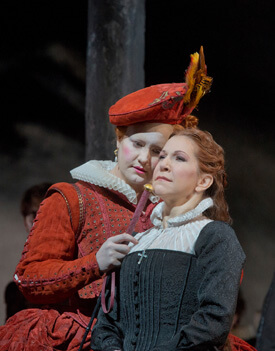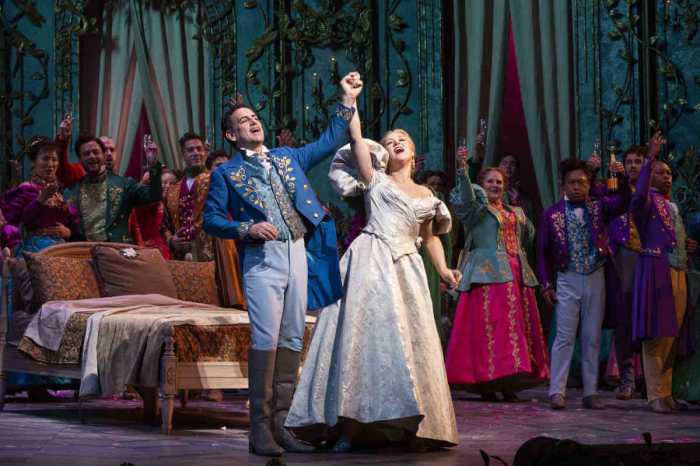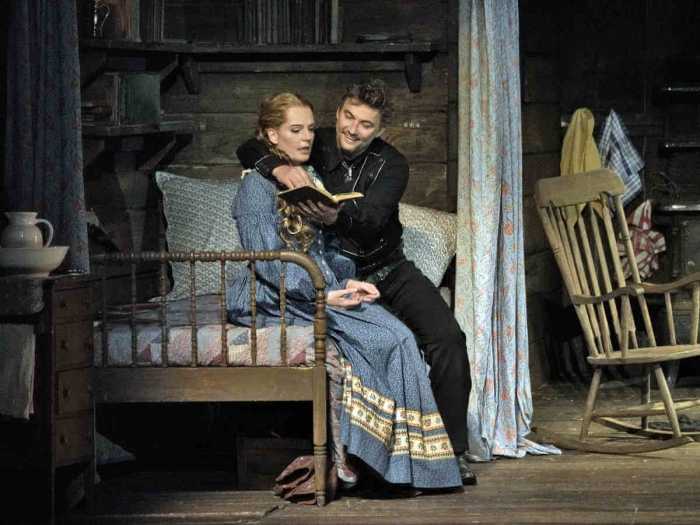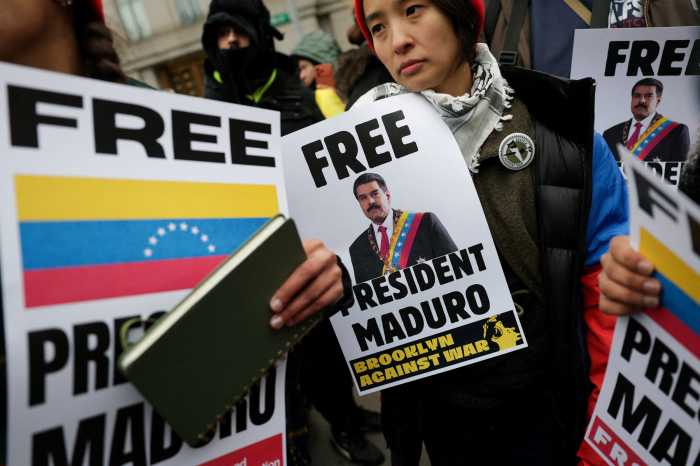Elza van den Heever as Elisabetta and Joyce DiDonato in the title character of Donizetti's “Maria Stuarda.” | KEN HOWARD/ METROPOLITAN OPERA
Donizetti’s “Maria Stuarda” (1834) had a difficult birth — the opera was banned at the dress rehearsal in Naples when the queen of Naples was horrified at the onstage royal execution. Soprano Giuseppina Ronzi de Begnis as Mary Stuart tussled for real with the rival soprano singing Elizabeth I. The next year at Milan’s La Scala, Maria Malibran sang the actual world premiere but was in wretched voice. The work, after few revivals, disappeared until 1958 when it reemerged in a corrupt edition in Bergamo. Rudolf Bing, in the late ‘60s, intended to mount a Met “Three Tudor Queens” cycle including “Stuarda” for Montserrat CaballÄ. He abandoned his plan when Beverly Sills, across the plaza, seized the triple crown for herself.
The Metropolitan Opera finally got around to “Maria Stuarda” on New Year’s Eve 2012 and it was worth the wait. David McVicar provided a visually striking, straightforward production that let the work speak for itself. A vocally gifted cast had no weak links and performed with commitment and sensitivity. However, the Met cast a mezzo-soprano as Maria Stuarda, a decision that has little musicological basis and doesn’t fit Donizetti’s musical characterization.
“Maria Stuarda” enters Met repertory, OONY takes on “Andrea Chenier”
Donizetti portrays the historical Mary Stuart as a Catholic martyr with a high-lying vocal line, giving an ethereal cast to her character. It is the highest and most lyrical of the three queens. For Joyce DiDonato, the soprano line was transposed down a half or whole tone throughout. But the vocal writing keeps pushing the brilliant American mezzo to the top of her range and keeping her there. In her opening cavatina, “O Nube che lieve,” and final prayer, “Deh, tu di un’umile preghiera,” sustained high phrases turned reedy, straight-toned with a slight beat. One missed the brilliant high C’s and D’s with which Sills and Sutherland crowned the ensembles.
However, like an earlier mezzo Maria, Dame Janet Baker, DiDonato brings a fierce inner conviction and deep humanity to her roles. In Act II, her rich middle voice with its burnt umber colorations brought searing intensity to Mary’s prison confession to Talbot. Each word of the libretto spoke truth. The fleet, articulate coloratura and trills delineated inner character and emotion like a musical polygraph. Her Queen of Scots was both intensely proud and desperately fragile, struggling to stay true to herself in a hostile environment. In her final farewell, DiDonato was deeply moving.
South African soprano Elza van den Heever made her Met debut as a brilliant-voiced soprano Elisabetta — her cool Germanic sound suggesting a more calculating monarch. I would have liked a stronger chest register, and her unvaried bright tone sounded rather youthful and lacked bite in declamatory passages. Matthew Polenzani as Leicester was dulcet and musical. His tone sometimes turned tight and bleaty under pressure, but he shapes the music sensitively.
Matthew Rose’s warm, enveloping bass-baritone made Talbot a refuge of sympathy and strength for the doomed Mary. Maria Zifchak’s lovely mezzo radiated kindness as Anna Kennedy, while Joshua Hopkins had the proper energetic ferocity as Cecil. Maurizio Benini’s elegant conducting seemed to be following the singers rather than pushing the drama forward.
McVicar’s production in Act I seemed a conventional historical drama — a latterday John Copley with more chic, stylized scenery. McVicar’s work gained focus and power in Act II, where the time frame moves forward 20 years. John McFarlane’s sets created unforgettable images — towering walls obliquely illuminated with shafts of light and the high scaffold stairs and block lit from above. “Maria Stuarda” emerged as a long overdue masterwork that finally found its place in the Met’s repertory.
The poet protagonist of Giordano’s “Andrea Chenier” is another political martyr, who loses his head during the French Revolution. On January 6, Opera Orchestra of New York mounted “Chenier” as a concert vehicle for Roberto Alagna in a role debut. As vehicles go, this one almost drove off the road several times. The star tenor and conductor/ musical director were at fault. Alberto Veronesi conducted without a score, with a wide palette of colors but brash loud dynamics and exaggerated tempos. When Alagna began the introduction to his opening aria, “Un dô all’azzurro spazio,” the conductor jumped a beat ahead and the tenor and orchestra parted ways. Alagna stopped Veronesi, and after some discussion they went back to the soprano’s earlier cue.
Despite an obvious cold, Alagna’s handsome Mediterranean tone sounded well enough except at the very top of his voice. But it was obvious that the underprepared Alagna had little sense of how the famous aria went, approximating note values on every phrase, something that continued all afternoon. He constantly finished lines before or after the orchestral accompaniment. His face was buried in the score throughout.
Later in Act II, Alagna was offstage during a crucial phrase over the ensemble — the music went on without him and he entered late with a saucy grin. By the final duet, Alagna’s high notes began to fade. Veronesi poured on Hollywood bombast, oblivious to the tenor’s imploring looks. Alagna’s final high note cracked.
The afternoon belonged to Romanian baritone George Petean, whose rich tone, stylistic authority, and ringing high notes made a vocal feast of Carlo Gérard — his third act solo, “Nemico della Patria,” stopped the show. Octogenarian mezzo Rosalind Elias as La Vecchia Madelon was the other audience favorite — a moving presence with weathered but resonant tone. Kristin Lewis as Maddalena di Coigny sang with an attractive, brightly focused big lyric soprano that only lacked control at softer dynamics and had a weak chest register. Let us hope that “I Lombardi” on April 8 is more worthy of OONY’s artistic heritage.




































